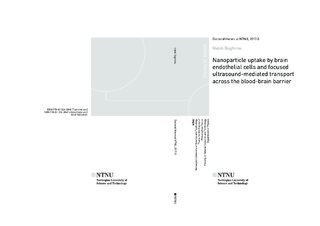Nanoparticle uptake by brain endothelial cells and focused ultrasound-mediated transport across the blood-brain barrier
Doctoral thesis
Permanent lenke
http://hdl.handle.net/11250/2431163Utgivelsesdato
2016Metadata
Vis full innførselSamlinger
- Institutt for fysikk [2695]
Sammendrag
More and more people in the world suffer from various brain diseases such as Parkinson’s disease, Alzheimer’s disease and brain cancer. One of the reasons it is so difficult to treat them is the blood-brain barrier (BBB) - an interface between blood and the brain. It prevents the passage of almost all drugs to the brain. Nanoparticles (NPs) can enhance drug delivery, but crossing the BBB is a challenge for NPs as well. Focused ultrasound (FUS) in combination with microbubbles can help them reach target sites in the brain. When exposed to FUS, microbubbles expand and collapse. When this happens close to the BBB, the barrier is disrupted.
In this thesis, we first studied how changes made in NP systems affected their interactions with cells. We also learned how these interactions can be predicted using artificial cell membranes. After that, we investigated how some properties typical for the NPs we were using affected their cellular uptake and degradation inside cells. Then we studied NP transport across the BBB. The uptake of our NPs by the cells forming the BBB was high, but their transport across the BBB was very low. We therefore decided to use FUS with microbubbles to open the BBB and deliver NPs into the brain. We successfully did that in a melanoma brain metastasis model. The NPs we used in that study were on the surface of microbubbles, and this close proximity could help us deliver a large number of NPs into the brain.
Brain diseases, including brain cancer, remain a great challenge, and most therapeutic approaches are ineffective. Drug delivery across the BBB is a key issue. Our work shows that proper characterization and optimization of NPs, as well as the use of versatile BBB-opening methods such as FUS can deliver drug-loaded NPs into the brain in large numbers.
